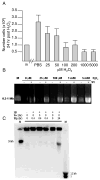TRANSCRIPTIONAL AND PHOSPHO-PROTEOMIC SCREENS REVEAL STEM CELL ACTIVATION OF INSULIN-RESISTANCE AND TRANSFORMATION PATHWAYS FOLLOWING A SINGLE MINIMALLY TOXIC EPISODE OF ROS
- PMID: 21743783
- PMCID: PMC3131088
TRANSCRIPTIONAL AND PHOSPHO-PROTEOMIC SCREENS REVEAL STEM CELL ACTIVATION OF INSULIN-RESISTANCE AND TRANSFORMATION PATHWAYS FOLLOWING A SINGLE MINIMALLY TOXIC EPISODE OF ROS
Abstract
Elevated reactive oxidative species (ROS) are cytotoxic, and chronic elevated levels of ROS have been implicated in multiple diseases as well as cellular transformation and tumor progression. However, the potential for a transient and minimally toxic episode of ROS exposure, or a minimal threshold dose of ROS, to initiate disease or cellular transformation is unclear. We examined both transcriptional and phospho-proteomic responses of murine embryonic stem (ES) cells to a single brief exposure of minimally toxic hydrogen peroxide (H(2)O(2)). The cellular response was distinct from those induced by either an acute exposure to H(2)O(2) or the topoisomerase II poison etoposide. Analysis of tumorigenesis-related transcripts revealed a significant up-regulation of oncogenes and down-regulation of tumor suppressors. Analysis of the phospho-proteomic response demonstrated insulin-signaling induction, including insulin receptor Y972 hypophosphorylation, similar to insulin-resistance mouse models and observed in diabetic patients. In addition, ES cells were more resistant to ROS than differentiated cells, and retained their transcriptional self-renewal signature, suggesting stem cells have a higher potential for ROS-mediated mutagenesis and proliferation in vivo. These results are a direct demonstration that even brief and non-toxic exposures to ROS may induce transduction of insulin resistance and transformation signaling in stem cells leading to diabetes and cancer.
Figures



Similar articles
-
[Quercetin Alleviates H2O2-Induced Oxidative Stress Damage to Human Endometrial Stromal Cells by Inhibiting the p38 MAPK/NOX4 Signaling Pathway].Sichuan Da Xue Xue Bao Yi Xue Ban. 2024 May 20;55(3):552-558. doi: 10.12182/20240560107. Sichuan Da Xue Xue Bao Yi Xue Ban. 2024. PMID: 38948281 Free PMC article. Chinese.
-
ROS constitute a convergence nexus in the development of IGF1 resistance and impaired wound healing in a rat model of type 2 diabetes.Dis Model Mech. 2012 May;5(3):375-88. doi: 10.1242/dmm.007872. Epub 2012 Feb 23. Dis Model Mech. 2012. PMID: 22362362 Free PMC article.
-
Cadmium-induced cell transformation and tumorigenesis are associated with transcriptional activation of c-fos, c-jun, and c-myc proto-oncogenes: role of cellular calcium and reactive oxygen species.Toxicol Sci. 2001 Jun;61(2):295-303. doi: 10.1093/toxsci/61.2.295. Toxicol Sci. 2001. PMID: 11353138
-
Redox paradox: insulin action is facilitated by insulin-stimulated reactive oxygen species with multiple potential signaling targets.Diabetes. 2005 Feb;54(2):311-21. doi: 10.2337/diabetes.54.2.311. Diabetes. 2005. PMID: 15677487 Free PMC article. Review.
-
Role of oxidative stress in cadmium toxicity and carcinogenesis.Toxicol Appl Pharmacol. 2009 Aug 1;238(3):209-14. doi: 10.1016/j.taap.2009.01.029. Epub 2009 Feb 21. Toxicol Appl Pharmacol. 2009. PMID: 19236887 Free PMC article. Review.
Cited by
-
Roles of reactive oxygen species in the fate of stem cells.Antioxid Redox Signal. 2014 Apr 20;20(12):1881-90. doi: 10.1089/ars.2012.4963. Epub 2012 Nov 19. Antioxid Redox Signal. 2014. PMID: 23066813 Free PMC article. Review.
-
Supplementing Glycine and N-acetylcysteine (GlyNAC) in Aging HIV Patients Improves Oxidative Stress, Mitochondrial Dysfunction, Inflammation, Endothelial Dysfunction, Insulin Resistance, Genotoxicity, Strength, and Cognition: Results of an Open-Label Clinical Trial.Biomedicines. 2020 Sep 30;8(10):390. doi: 10.3390/biomedicines8100390. Biomedicines. 2020. PMID: 33007928 Free PMC article.
-
Effect of increasing glutathione with cysteine and glycine supplementation on mitochondrial fuel oxidation, insulin sensitivity, and body composition in older HIV-infected patients.J Clin Endocrinol Metab. 2014 Jan;99(1):169-77. doi: 10.1210/jc.2013-2376. Epub 2013 Dec 20. J Clin Endocrinol Metab. 2014. PMID: 24081740 Free PMC article. Clinical Trial.
-
Ultraviolet Radiation-Induced Skin Aging: The Role of DNA Damage and Oxidative Stress in Epidermal Stem Cell Damage Mediated Skin Aging.Stem Cells Int. 2016;2016:7370642. doi: 10.1155/2016/7370642. Epub 2016 Apr 11. Stem Cells Int. 2016. PMID: 27148370 Free PMC article. Review.
-
Real-Time H2 O2 Measurements in Bone Marrow Mesenchymal Stem Cells (MSCs) Show Increased Antioxidant Capacity in Cells From Osteoporotic Women.J Cell Biochem. 2017 Mar;118(3):585-593. doi: 10.1002/jcb.25739. Epub 2016 Oct 17. J Cell Biochem. 2017. PMID: 27632788 Free PMC article.
References
Grants and funding
LinkOut - more resources
Full Text Sources
Molecular Biology Databases
